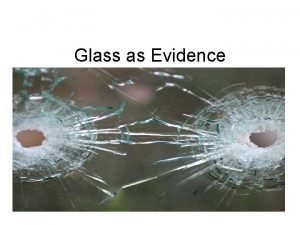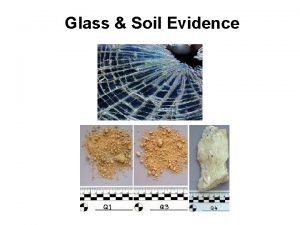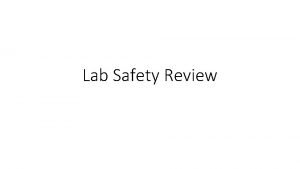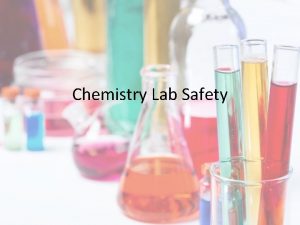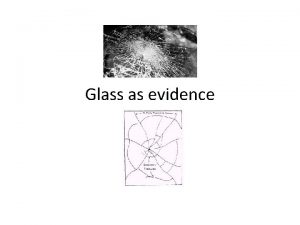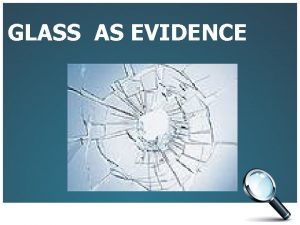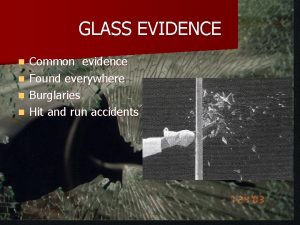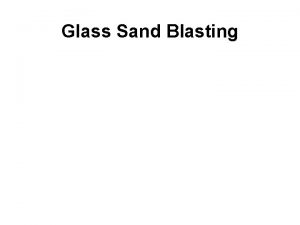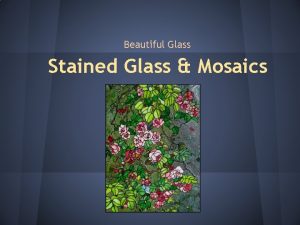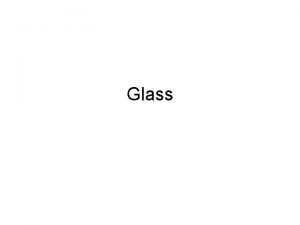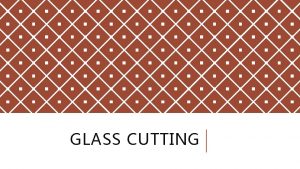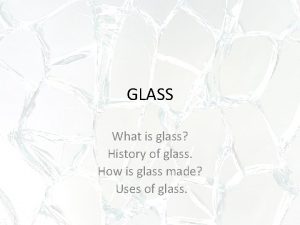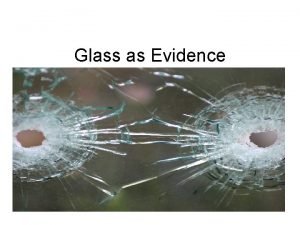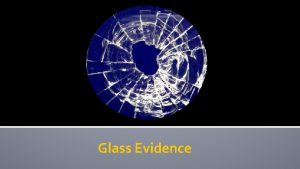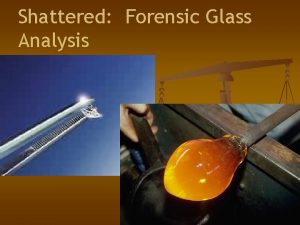Glass Evidence Ouch Importance of Glass Commonly found






































- Slides: 38

Glass Evidence Ouch!

Importance of Glass Commonly found at crime scenes in the form of broken … • bottles • windows • headlights • eyeglasses Easily transferred to … • suspect's clothing • embedded in shoes • victims of hit and run

Importance of Glass • Glass is class evidence, if it can be identified as a kind of glass based on its composition and physical properties • Glass can be individualized only if the broken pieces can be fit together, like a jigsaw puzzle – almost impossible – overwhelming number of pieces

What is Glass? • silicon dioxide, Si. O 2 • silica • Commonly found in nature as sand or quartz • an amorphous solid • non-crystalline • disorderly arrangement of atoms • transparent

Physical Properties of Glass A characteristic that can be measured without changing the identity of the substance Can be used to classify glass – Color – Density – Refractive index – Fracture pattern

Color • Natural glass is slightly green due to the iron oxide in sand, adding manganese “cleans up” the color • Adding more manganese makes it purple • Small amounts of other elements can change the color • Moldavite is a natural glass formed from a meteorite impact Moldavite

Compounds iron oxides Colors greens, browns manganese oxides deep amber, purple, decolorizer cobalt oxide deep blue gold chloride selenium compounds carbon oxides mangnese + cobalt + iron antimony oxides uranium oxides sulfur compounds copper compounds tin compounds lead with antimony ruby reds amber/ brown black white yellow green (glows!) amber/ brown light blue, red white yellow



Types of Glass 1. Soda-lime glass – most common: 90% of glass produced – least expensive form of glass – Soda reduces the melting point of silica, lime makes the sodium silica insoluble in water – not resistance to high temperatures or sudden changes of temperature – used to make bottles, some drinking glasses and windows

Types of Glass 2. Borosilicate glass – at least 5% boric oxide – high resistance to temperature change and chemical corrosion – light bulbs, photochromic glasses, sealed-beam headlights, laboratory glass and bake ware

Types of Glass 3. Lead Glass – relatively soft, making it easier to cut into crystals – adding lead oxide (Pb. O) to glass increases the density and the refractive index, which makes it sparkle – more expensive than soda-lime glass – will not withstand high temperatures or sudden changes in temperature – thermometer tubing, art glass, crystal decanters

Types of Glass 4. Aluminosilicate glass – aluminum oxide in its composition – similar to borosilicate glass but it has greater chemical durability and can withstand higher operating temperatures – coated with an electrically conductive film, and used as resistors for electronic circuitry

Types of Glass 5. Fused silica glass – processed to remove almost all the non-silicate elements – most expensive of all types – resistant to heat shock up to 900°C and 1200°C – optical lenses in telescopes, fiber optics, space shuttle

Types of Glass 6. Tempered Glass – strengthened by rapidly heating and cooling the glass surface – when it breaks it “dices” into small squares pieces and does not shatter into sharp shards – used in side and rear car windows in cars – windshields of some foreign-made cars


Types Glass 7. Laminated Glass – has a layer of plastic sandwiched between two pieces of window glass – holds together when shattered – spiderweb cracking – skylight glass and windshields of cars manufactured in the United States


Types of Glass 8. Ancient Roman Glass – similar in composition to modern day soda-lime glass – earliest known glass was made in Mesopotamia (modern Iraq), 2500 BC The famous ancient – Romans produced beautiful Roman vase (Portland Vase), British Museum. vases and artwork It dates back to the last century BC


Analyzing Glass Evidence Physical properties of glass can be used to determine the type of glass found at a crime scene, like… 1) Density 2) Refractive index

Density • Physical property - can be measured or perceived without changing its identity • Describes the amount of matter in a given volume • Formula … density = mass (g) volume (ml or cm 3) • Intensive property = the same regardless of the size of the sample

Refraction When light travels from one medium to another, there is some change in velocity and therefore direction. This phenomenon is called refraction. Refraction is simply the bending of light as it passes from one medium to another. Light traveling from a less dense substance to a more dense substance, as from air to glass, will slow down.

Birefringence • The incoming light is broken into two rays • The two rays called ordinary and extraordinary have different velocities • Caused by anisotropic properties: crystalline structure is not the same in all directions

Birefringence Also called double refraction

Refractive Index • Ratio of the velocity of light in a vacuum to the velocity of light through a medium R. I. = speed of light in a vacuum speed of light through a medium • Intensive property: refractive index is the same regardless of size • Snell’s Law: R. I. = sin(angle of incidence) sin(angle of refraction)

Refractive Index If a piece of glass is immersed in a liquid with the same refractive index … • Velocity of light will not change • No refraction = light will not change direction / bend • Glass will disappear • Match point refractive index of liquid and glass are the same

Becke Line When the piece of glass is immersed in a liquid with a different refractive index …. – a rim of light will appear at the edge of the glass piece – looks like a halo of light – either on the inside or outside edge – called a Becke line

If the Becke line appears on the inside of the edge of glass, then the glass has a higher refractive index the investigator will need a liquid with a higher refractive index.

If the Becke line appears on the outside edge of the glass, then the liquid has a higher refractive index the investigator will need a liquid with a lower refractive index.

** The medium with the greater refractive index has the Becke line

Broken Glass • Glass is slightly flexible, but when forced beyond it elastic limit it will break or fracture • Investigators can reconstruct a crime scene using fracture patterns and blow back • Blowback: because of the elasticity of glass, some of the fragments will recoil backwards toward the direction of force, thus possible leaving clues on the perpetrator's clothing, hair, etc. • A high velocity projectile will always leave an exit hole larger than the entrance hole

Fracture Patterns 1) • • Radial Fractures first cracks to form on the opposite side of the force cracks extend outward at all angles like the spoke of a wheel 2) Concentric Fractures • second cracks to form • form on the same side as force applied • circular cracks around the point of impact


Stress Marks • Found on thin edge of glass • Shaped like arches • Parallel to one side and perpendicular (right angle) to the other side • Can reveal the side that the force was applied • “Radial cracks form Right angle on the Reverse side of the force”

Radial fracture stress marks Stress marks Impact Initial applied force occurs on this side

Concentric fracture stress marks Stress marks Impact Second applied force on this side, due to elasticity

Determining the sequence of bullet holes in glass A fracture always terminates at an existing line of fracture
 Oh is a conjunction
Oh is a conjunction Welcome to the ouch
Welcome to the ouch Welcome to the ouch
Welcome to the ouch They have always breakfast in bed
They have always breakfast in bed Define ecological fallacy
Define ecological fallacy Secondary sources
Secondary sources Class vs individual evidence
Class vs individual evidence Primary evidence vs secondary evidence
Primary evidence vs secondary evidence Explain how class evidence may be useful
Explain how class evidence may be useful Primary evidence vs secondary evidence
Primary evidence vs secondary evidence Primary evidence vs secondary evidence
Primary evidence vs secondary evidence Class vs individual evidence
Class vs individual evidence Primary evidence vs secondary evidence
Primary evidence vs secondary evidence Is fiber class evidence
Is fiber class evidence Importance of citing sources
Importance of citing sources Becke line forensics
Becke line forensics Glass evidence in forensic science
Glass evidence in forensic science If acid is splashed on your skin, wash at once with *
If acid is splashed on your skin, wash at once with * Does hot glass look like cold glass
Does hot glass look like cold glass Glass ceiling vs glass escalator
Glass ceiling vs glass escalator What is pattern development in technical drawing
What is pattern development in technical drawing Commonly confused words paragraph
Commonly confused words paragraph Name and describe the three types of hair presses
Name and describe the three types of hair presses Altered cognition in older adults is commonly attributed to
Altered cognition in older adults is commonly attributed to Most commonly used system
Most commonly used system Classification of clutch
Classification of clutch Virtual memory is commonly implemented by
Virtual memory is commonly implemented by A commonly cited hazard for stairways and/or ladders is
A commonly cited hazard for stairways and/or ladders is Commonly damaged areas of a vehicle during hoisting
Commonly damaged areas of a vehicle during hoisting Financial difficulties are commonly caused by overspending
Financial difficulties are commonly caused by overspending Abused children commonly exhibit
Abused children commonly exhibit Chapter 7 drivers ed
Chapter 7 drivers ed Hose appliances
Hose appliances List three of the commonly used assembly constraints
List three of the commonly used assembly constraints A pneumatic drill is commonly used
A pneumatic drill is commonly used Sodium hydroxide relaxers are commonly called
Sodium hydroxide relaxers are commonly called Types of optical storage
Types of optical storage Signing naturally - homework 5:8
Signing naturally - homework 5:8 Commonly misused homonyms
Commonly misused homonyms















